Last year I collected a Polish-Lithuanian Commonwealth Army for Tilly’s Very Bad Day. They are what got me interested in the Northern Wars. Actually it was the Gustavus Adolph’s campaigns against them that got me interested – he formed his military ideas in the Livonia fighting the Commonwealth before sailing to German for the Thirty Years War.
I thought I’d share some photos. Rather than have a separate painting guide I’ll give painting guidelines here.
The whole army
I think I have 39 units with a few more in the pipeline. This is a massive army for Tilly’s Very Bad Day and I may have got a bit carried away. It just looks so pretty.
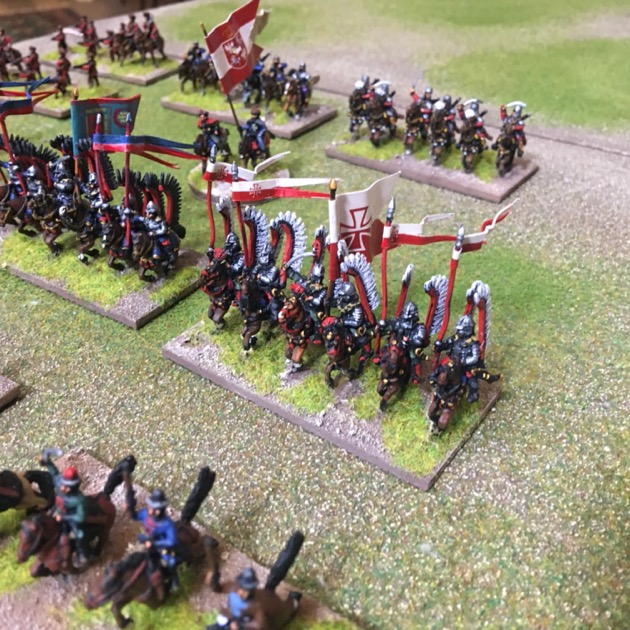
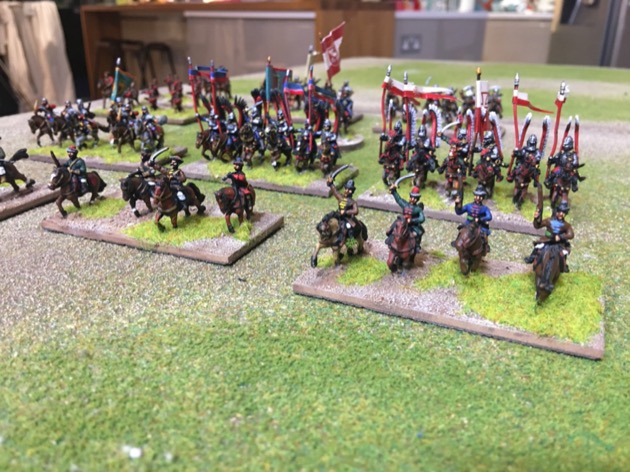

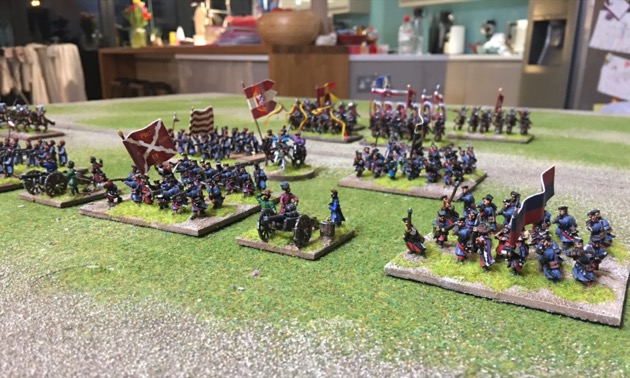




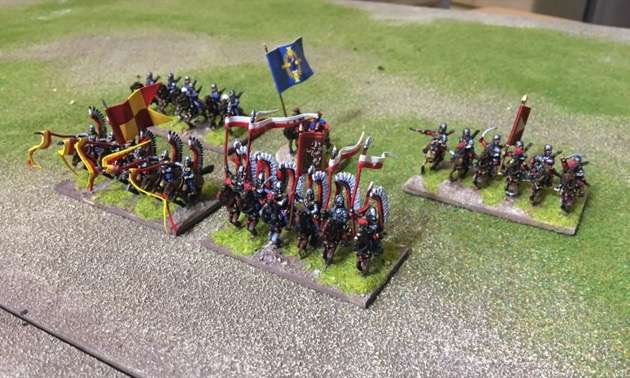


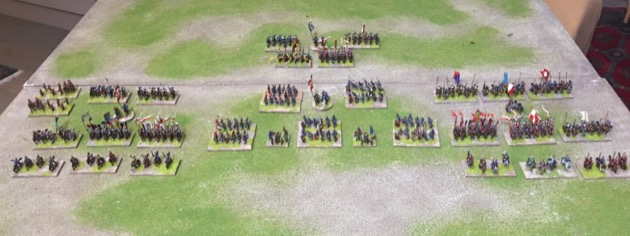
Parts of the Army
Firstly, a bit about terminology. In English we talk about “Cossacks” but Polish sources distinguished kozacy and Kozacy, notice the capital “K” (Paradowski, 2020). The first of these, kozacy, meant free men ‘serving for money’ and referred to regular Polish cossack cavalry. The second word, Kozacy, meant the Zaporozhian Cossacks from the Ukraine. So “Cossack” in the Polish-Lithuanian army does not mean Zaporozhian Cossack. The Registered Cossacks were all Zaporozhian and perhaps the majority of dragoons were too. Zaporozhians probably appeared in other units. But the majority of “Cossacks” in the Polish-Lithuanian Army were Polish or Lithuanian.
I have previously written up the Army of the Polish-Lithuanian Commonwealth. The army had the usual split between cavalry, infantry, and artillery, but this army was categorised in other ways as well. The Commonwealth had three weights of cavalry, which in modern terms are called heavy, medium and light although in 17th Century Poland these categories were called Hussars, Pancerni and light cavalry (Brzezinski, 1987). ‘Foreign’ or ‘German’ cavalry were considered mediums alongside the Pancerni. The major divisions in the infantry were Haiduks, Registered Cossacks, ‘Foreign’ or ‘German’ infantry, and dragoons. Haiduks were Polish-Hungarian in style, as were the Wybraniecka levy at the start. Registered Cossacks differed from Polish infantry only in their hat.

Commanders
I have four sets of commanders. The boss has 3 mounted figures and the others have 2 mounted figures. Commanders wore what they liked. Red would have been popular. And gilt/gold.



Cavalry Painting Guide
The three categories of cavalry were equipped differently but those dressed in native style wore similar colours. The more wealthy men would wear whatever they wanted. But they also provide “uniforms” for their poorer retinue. A magnate would provide uniforms for their entire unit (whether company or larger).
Painting guide for Hussars, Pancerni, and Petyhorcy:
- Lance (if any): Red.
- Welens/Kilims cloak (if any): Some hussars wore a striped woollen cloak reminiscent of Navajo blankets (Brzezinski, 2006). One example is scarlet with yellow stripes. Brzezinski has an illustration of a brown cloak with blue, yellow and red stripes. Poorer men could wear a plain welens.
- Steel Armour: Burnished (Brzezinski, 2006) and inlaid with brass (Gush, 1975). In this period ¾ plate with mail sleeves was standard for Hussars (Brzezinski, 2006). But poorer Hussars would wear less. Pancerni and Petyhorcy wore mail.
- Leather skirt (if worn): buff (Gush, 1975)
- Tunic/Coat/trousers: Gush (1975) mentions red, brown or deep blue for tunic/coat. Red was probably most common colour because it was the colour preferred by the high nobility (Brzezinski, 2006). Blue was common amongst lesser nobility and hence poor Hussars. Other colours mentioned are parrot green, sulphur, coral, soot, pepper, cinnamon, clove (pink). The most common combination in the illustrations is a red tunic/coat with blue trousers.
- Boots: black, red,, or yellow (Gush, 1975). Illustrates also show red brown and buff. Although the “buff” might be the “yellow”.
- Scabbards: Red, green or black with silver or gilt fittings (Gush, 1975).
- Saddle cloth: Basic colour wine red with silver or gilt fringes (Gush, 1975). Welens cloask were similar to saddle cloths and several illustrations show these striped e.g. blue with yellow and black stripes (Brzezinski, 2006).
- Horse harness etc: Gush (1975) mentions yellow, red, green, blue or brown leather. With gilt or silver studs and fitting.
- Officers: would carry a gilt mace, and might wear a fur-trimmed cap with long, trailing point (Gush, 1975).
Hussars (Heavy Cavalry)
The Hussars were the main strike force (Brzezinski, 1987, 2006). They carried a lance, two swords (sabre and a long sword), and two pistols. Some also carried a carbine. The lance was their primary weapon and well supplied armies could issue replacements during a battle. Most Hussars were armoured but the poorer men were not. Being the elite of the army, Hussars were more fancy than other types of cavalry.
-
Hussar Wing Feathers: Based on illustrations the options are white, black or white with black tips.
Hussar Wing Frame: Red (?) and gilt (Gush, 1975).
Hussar Lance Pennon: Uniform within a unit: Hussars used Red/white, blue/white, yellow/black, white/black, black/yellow (Brzezinski, 2006). Gush (1975) also mentions blue for Hussars.
Hussar Animal Skin Cloak: Leopard, panther, tiger, lynx skin (Brzezinski, 2006 ; Gush, 1975). Regardless of the name this was probably Lynx because it is native to the area. Poorer men substituted wolf skin.



I have six units of Hussars each with six men. Each unit has a semi-uniform including common elements and individual deviations. The common hussar uniform elements, for all units, are:
- Animal fur cloak: Spotted Cat (Lynx)
- Armour: Burnished (bright steel) inlaid with brass
- Lance: Red
- Wing frames: All frames seem to have been red with gilt.
- Pistol holsters: Red flap with brown leather barrel
- Musician: Blue Tunic. Blue hat with white fur (Although I ended up not including the musician figures)
The individual elements are:
- Officers would wear whatever they liked but they might adopt the uniform if it suited them.
- Any particular individual trooper might break the uniform for a tunic/coat, trousers, boots, or scabbard
- Poorer men might substitute wolf for spotted cat skin.
The following table shows how the six units of Hussars differ.
| Hussar Unit | Wing Feathers | Tunic / Coat | Trousers | Boots | Scabbard | Lance Pennon | Saddle cloth |
|---|---|---|---|---|---|---|---|
| Unit 1 (Sobieski) | White | Green | Blue | Red (not red brown) | Green | Black/yellow | Wine red |
| Unit 2 | White | Red | Blue | Black | Black | Red/white | Blue striped yellow and black |
| Unit 3 | Black | Red | Blue | Buff | Black | White/black | Wine red |
| Unit 4 | Black | Deep Blue | Red | Black | Black | Blue/white | Blue stripped white |
| Unit 5 | White with black tips | Red | Blue | Buff | Red | Red/white | Wine red |
| Unit 6 | White with black tips | Red | Blue | Red brown | Black | Red/White | Brown striped red and white |
Hussar Unit 1 (Sobieski)
Hussar Unit 1 is based on the hussars of John III Sobieski. John III was King of Poland and Grand Duke of Lithuania from 1674 until his death in 1696. He fought in the Khmelnytsky Uprising, the Russo-Polish War and during the Swedish invasion known as the Deluge. But he is most famous for his victory over the Turks at the Battle of Vienna in 1683, after which the Pope hailed him as the saviour of Western Christendom. I only picked this uniform because it is relatively well known because of a painting from the victory parade at Vienna.






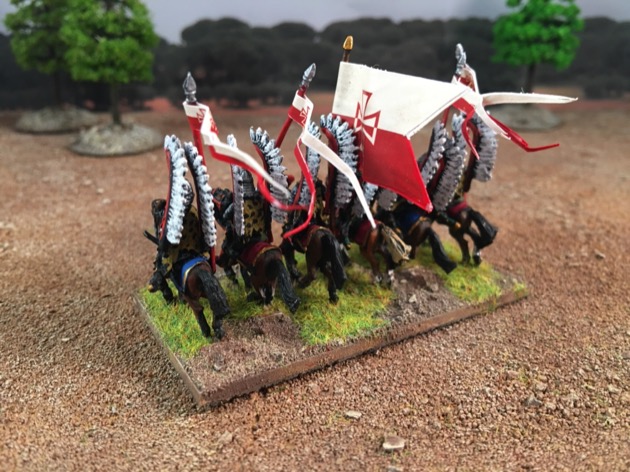
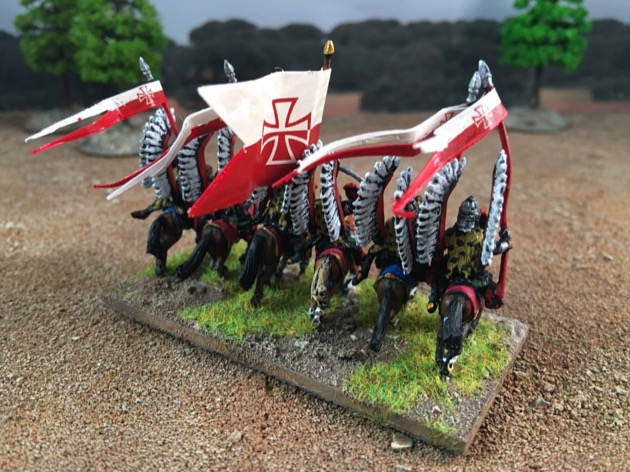

Hussar Unit 2
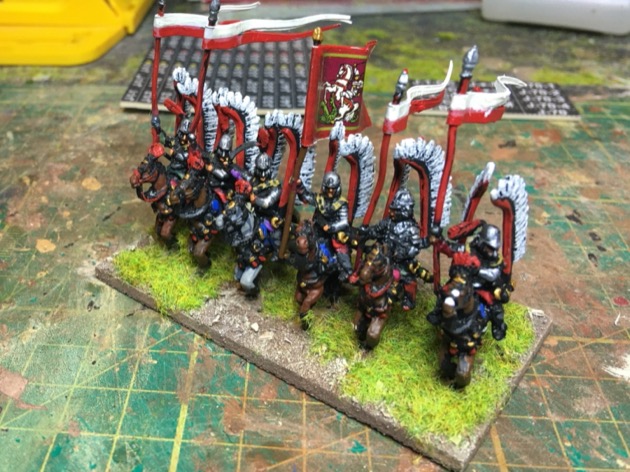




Hussar Unit 3
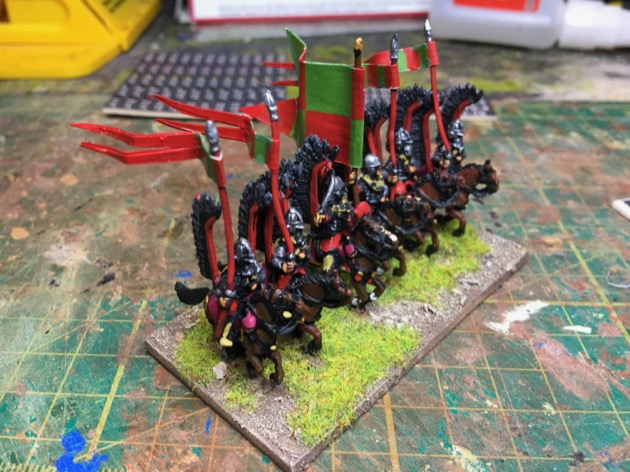




Hussar Unit 4

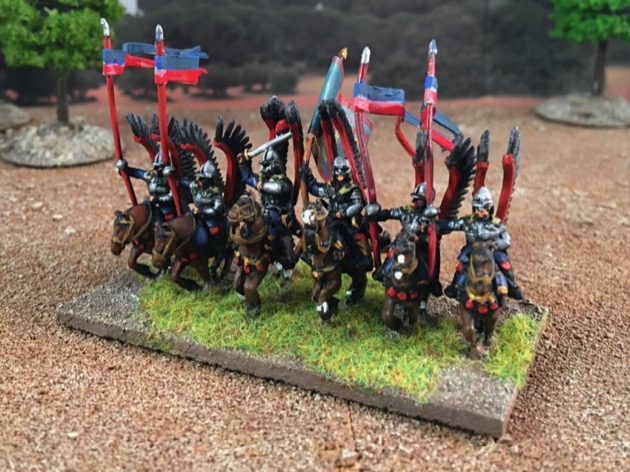

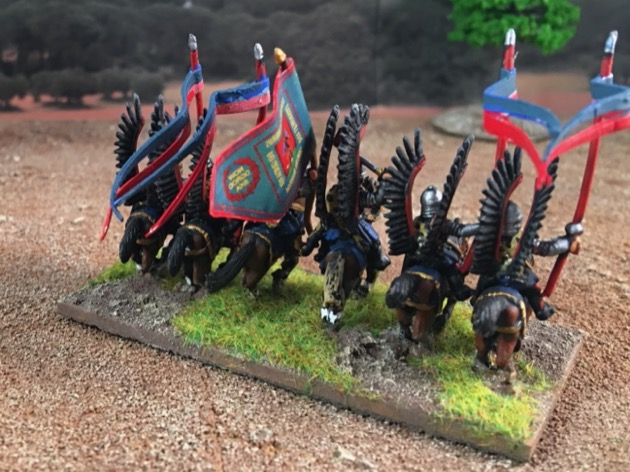

Hussar Unit 5

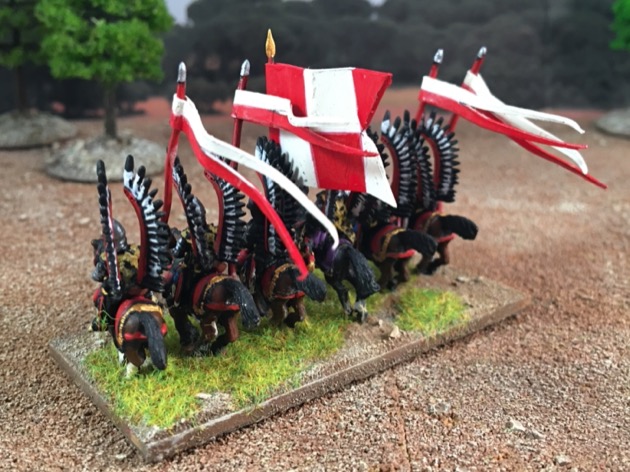

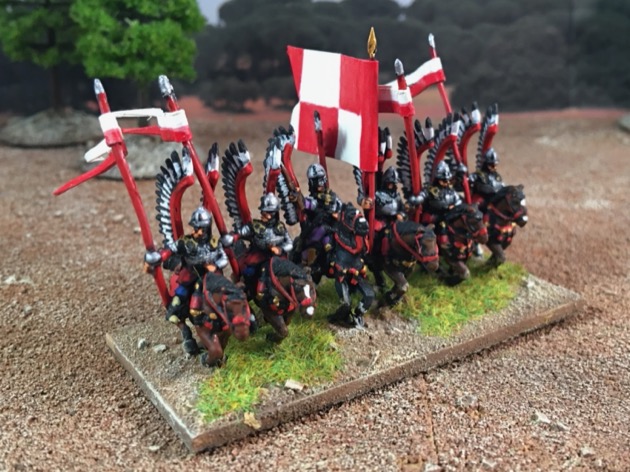
Hussar Unit 6





Medium Cavalry
The medium cavalry supported the Hussars. Often this meant shooting them in, but they also charged. Initially the Polish mediums were part of the larger “Cossack” cavalry, with some Cossacks also being light cavalry. Over time the armoured Cossacks were renamed “Pancerni”. In Lithuania the mediums were called Petyhorcy and some were actual Circassians who had resettled and brought their tribal name with them. German speaking cavalry were variously called ‘Foreign’ ‘German’ and Reiter (rider in English and Rajtar in Polish) and were sub-categorised as Cuirassier, Arquebusiers, or just Reiter.
Pancerni
The armoured Cossack cavalry ended up being called Pancerni. Remember that, despite being “Cossacks”, these were mostly Polish. I have five units of Pancerni (6 men on a single base) and each has a semi-uniform including common elements and individual deviations. All of the figures have sabres. Most have pistols or at least saddle holsters. Many have carbines. A few, the traditionalists, have bows. By the start of the 17th century the Pancerni had abandoned the lance for the carbine. Ironically the towards the end of the century, when the Hussars are declining, the Pancerni decided they’d made a mistake and adopted the lance again. From that point I can use my Petyhorcy as Pancerni.
Generally everything from the Hussar painting guide applies here. Except not so fancy. Red should dominate the colour scheme for most units. And the most common combination in the illustrations is a red tunic with blue trousers.
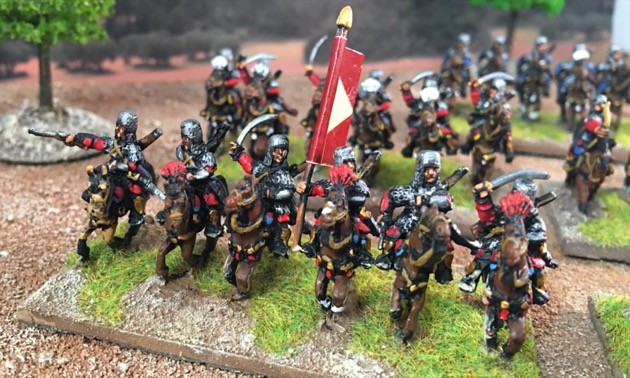








Lithuanian Petyhorcy
Lithuanian had some resident Circassians who provided armoured cavalry. The category of cavalry were called Petyhorcy after the part of the Caucuses where they originated. Native Lithuanians also adopted this style of cavalry, and the associated name, and it became the Lithuanian equivalent of the Polish Pancerni. Panceri and Petyhorcy are identical except the Petyhorcy retained lance and shield throughout the period whereas in the early 17th century the Pancerni had abandoned the lance for the carbine. This reflects the stronger western influences in Poland and the stronger eastern influences in Lithuania. Ironically the towards the end of the century, when the Hussars are declining, the Pancerni decided they’d made a mistake and adopted the lance again. So my Petyhorcy can also be late period Pancerni. They really are the same.
I have four units of Lithuanian Petyhorcy. Each unit has a semi-uniform including common elements and individual deviations. As with the Pancerni, everything from the Hussar painting guide applies here. Except not so fancy. Red should dominate the colour scheme for most units. And the most common combination in the illustrations is a red tunic with blue trousers.
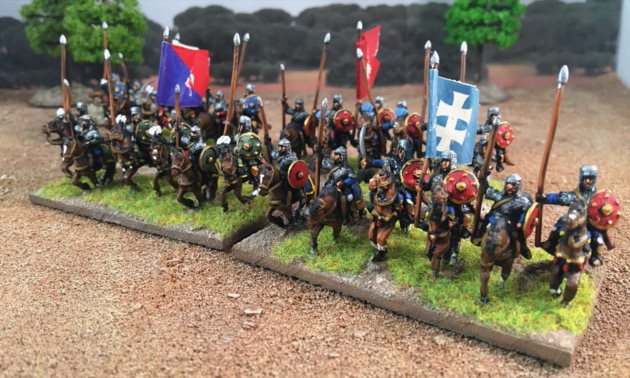


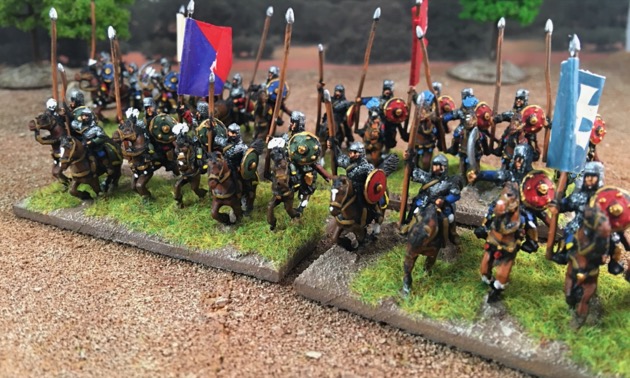

‘German’ Cavalry
The ‘Foreign’ cavalry were generally German speaking so were often called ‘German’. They were recruited from German speaking parts of Poland (think Prussia) or directly in Germany. Being German speakers that meant they were also called “Reiter” (rider or horseman in English and Rajtar in Polish). Like other western cavalry they started the period as either Cuirassier or Arquebusiers, but over time just became more lightly equipped horsemen (Reiter).
I don’t have dedicated ‘German’ cavalry for the Commonwealth army. I figure I can just reuse figures I have from my general Thirty Years War collection.

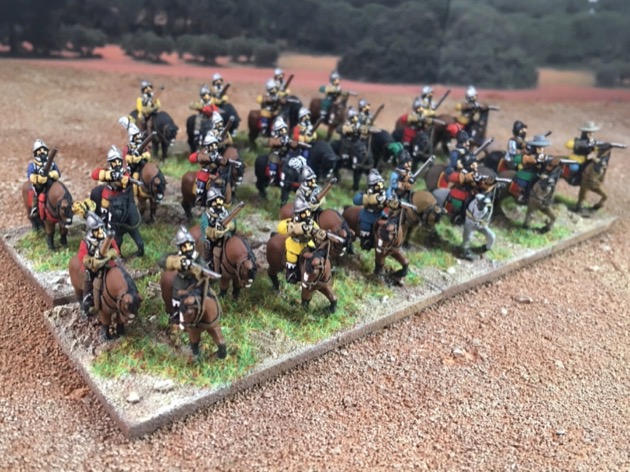
A typical Polish Reiter (Rajtar) of the mid-17th Century would have worn a brown felt hat, wide brown belt, brown trousers and boots, with a long buff leather coat and white gauntlets. He would be armed with two pistols and a sword (either a long sword or rapier).

Noble Levy
I have the unpainted figures for the Noble Levy but given I have so much Commonwealth cavalry already, I haven’t been in a rush to get it painted.
Light Cavalry
Early Polish light cavalry were part of a rather wide “Cossack” category. Later on the light cavalry were split out and reclassified as Wallachian or Tatar. Lithuania had a resident Tatar popular so fielded actual Tatar light horse throughout the period.
Cossacks
I have a bunch of Cossack light horse. More than I actually need. I might transfer some of these to my future Transylvanian army.
Whatever the light cavalry were called, they had much in common in terms of appearance. For Cossacks and Wallachians:
- Fur trim on fur cap: black/grey (most common) or brown
- Bag on Fur cap: red (most common) or black or other colours
- Caftan: light brown (most common), red, green, blue, yellow
- Trousers: red (most common), green, blue, grey, white
- Clock (if worn): red or anything else they fancied
- Shirt: White
- Boots: Black (most common), brown, or low yellow (in the Turkish style).
- Leather (straps + belt, etc): Brown or black.





Wallachians
I have the unpainted Wallachian figures but I really don’t need more light cavalry.
Wallachians tended to be more Hungarian in look and hat a preference for tall hats. But the general light cavalry painting guide applies (see Cossacks).
Tatar
I have the unpainted Tatar figures but I really don’t need more light cavalry.
Tatars were exclusively horse archers. Unlike other light cavalry Tatars might also carry a round shield and lariat.
The general light cavalry painting guide applies to Tatars (see Cossacks), but they might have these features as well:
-
Sheepskin for hat, coat and boots: black (for another day … the Crimean Khanate used white sheepskin)
Sheepskin Coat (if worn): In summer showing wool of Sheepskin (see above) or with leather showing in winter
Boots: Sheepskin (see above), red leather, or yellow leather
Cotton turban: white
Polish-Hungarian Infantry
The Haiduks were Polish-Hungarian in style, uniforms, weapons and fighting techniques. The Registered Cossacks looked the same as the Haiduks but with a Cossack hat. Wybraniecka levy started in Polish-Hungarian uniforms but eventually lost both uniforms and muskets and looked just like the peasants they were.
From what I can tell the Polish Infantry (Haiduks, Wybraniecka Levy) and Registered Cossack Infantry all shared the same uniform. The only difference is the Poles wore a black pill box cap and the Cossacks wore a fur hat. Polish officers also wore the Cossack fur cap.
Men, Standard bearers, Musicians:
- Hat:
- Either Polish Pillbox cap: Black with white feathers (Brzezinski, 1987)
- Or Cossack fur hat: Red top and with grey fur
- Coat: cloudy-blue (grey-blue) woollen cloth, with red collar, cuffs, and turnbacks (Brzezinski, 1987; https://en.wikipedia.org/wiki/Hajduk)
- Tunic (under the coat and might not be visible in this period): white
- Tight hose: Red (a minority of units had blue but go for red)
- Shoes: Black
Officers
- Officers wore what they liked (Gush, 1975).
- Cossack hats were popular even in Polish-Hungarian units where men wore Pillbox cap.
- Gush (1975) gives an example in fur cap with red plume, yellow shirt with buff coat and breeches with brown inserts, grey stockings and yellow shoes. Cloak blue with red lining.
- Red or yellow were favoured for boots and shoes (Gush, 1975).
Officer’s boy (the figures are shorter and have a 2-handed sword or mace over shoulder)
- Officer’s boy wore they the officer liked.
10th men (the NCO with spears; they wore reversed colours)
- Coat: Red with white collar, cuffs, and turnbacks
- Tight hose: green (if other men wore blue) or blue (if other men wore red)
- Otherwise as men above
A variety of blues were used but cloudy blue was most common. I guess a kind of grey-blue. So image below is my guess.

Haiduks
Haiduks are Polish infantry dressed and fighting in a Hungarian style. That means the terms “Haiduks”, “Polish infantry”, and “Polish-Hungarian infantry” are pretty interchangeable terms. Having said that, Haiduks in Polish service were sometimes actual Hungarians or Transylvanians.
I’ve got six units of 12 figures. Three of the bases have an Officer, Standard Bearer, Officer’s Boy, Musician, a Tenth Man, and 7 others. The other three bases have a Tenth Man and 11 others. The Tenth men were NCO types with a spear.



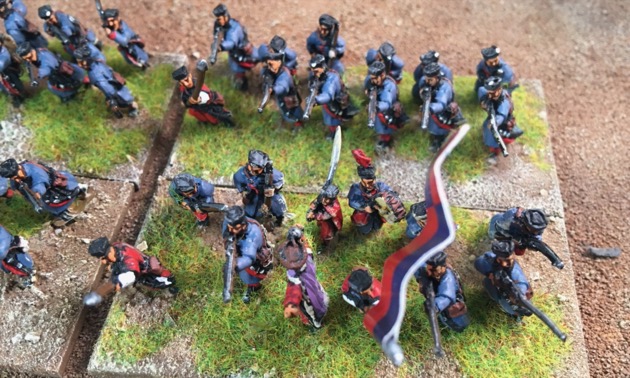

Registered Cossacks
From what I can tell the Registered Cossacks had the same uniform as the Polish Hungarian infantry i.e cloudy-blue coat etc. But they wore the Cossack fur cap in place of the Polish pill box cap.
I’ve got six units of 12 figures. Three of the bases have an Officer, Standard Bearer, Officer’s Boy, Musician, a Tenth Man, and 7 others. The other three bases have a Tenth Man and 11 others. The Tenth men were NCO types with a spear.
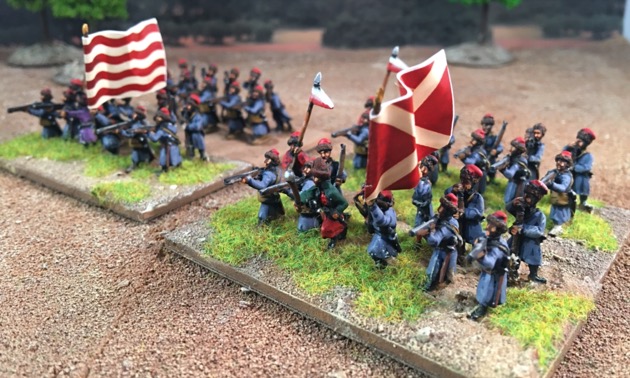
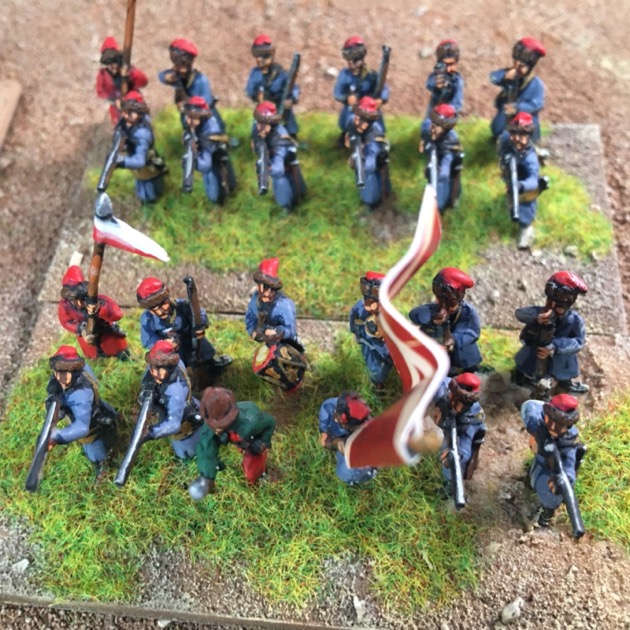
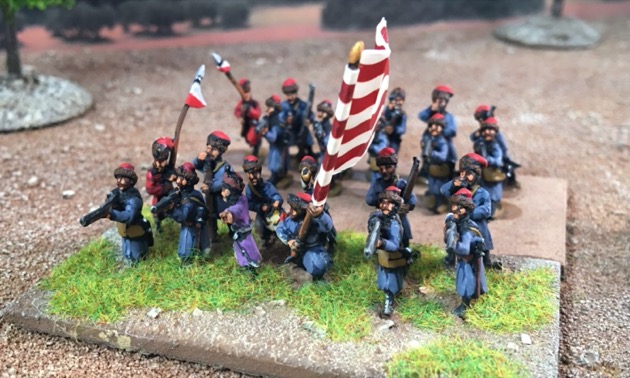

Wybraniecka levy
Early on Wybraniecka levy were dressed and equipped like the Haiduks. In fact I can just use my Haiduk figures for them.
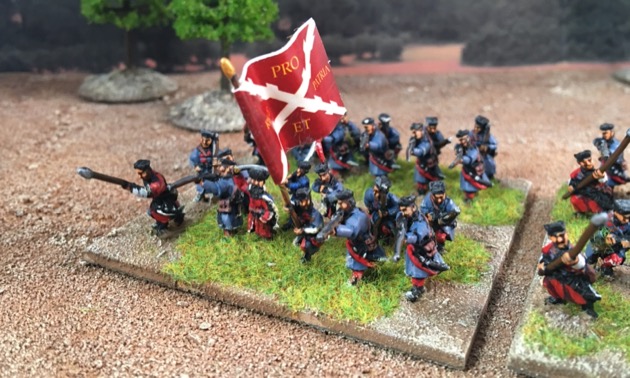
Over time the Wybraniecka levy didn’t perform so well and eventually the uniforms and firearms disappeared. My Wybraniecka levy are from the later period, when they were basically untrained peasants used as sappers. Polish peasants of the time wore brown or unbleached wool/linen for hat, coat, and trousers. Brown would dominate.
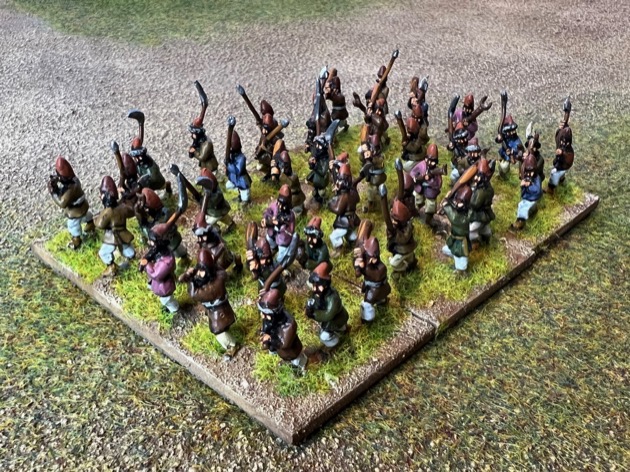




Dragoons
Two units with a couple of mounted figures and 6 dismounted.
The Polish Dragoons wore a uniform.
- Horse: Some regiments had the same horse colour in each company (Brzezinski, 1988). Given Dragoons got nags I’m guessing these would have been the more common bay or chestnuts; the big illustration is a bay.
- Horse furniture: plain brown leather (Gush, 1975)
- Cossack fur hat: Brown fur hat with, a red top (Brzezinski, 1988 ; Gush, 1975)
- Tunic: Most units wore red (Gush, 1975). In 1683 Sobieski’s Dragoons had red tunic with yellow lining/cuffs/turnbacks (Brzezinski, 1988). A minority of units wore blue tunics.
- Trousers: Black (Gush, 1975)
- Kerchief: White (Gush, 1975)
- Gauntlets (if worn): “Yellow” which probably means buff (Gush, 1975)
- Boots: tan to dark brown (Gush, 1975)
- Bandoliers: Light brown leather (Gush, 1975)
- Scabbard: Black leather (Gush, 1975)
- Officers: Once again officers probably wore what they liked




‘German’ Infantry
As with the ‘German’ cavalry, the ‘German’ Infantry were mostly recruited from German speakers. They were also know as the ‘Foreign’ infantry and although the vast majority of the men were German speakers, Europeans of various nations appeared as officers.
Any pike and shot infantry of the Thirty Years War will do. Apparently it was hard to tell the difference from ‘German’ infantry in Polish employ and Swedish infantry.


Artillery
I’ve got a couple of cannons and crew. I guess they wore what they liked.



Tabor
Like many of the eastern armies, the Polish-Lithuanian Commonwealth used fortified wagons. I’m still painting them up.
Flags
Most of the flags are from the excellent By Fire and Sword range.

I did supplement a little bit and made most of the Hussar lance pennons and the flag for Hussar Unit 5.

Acknowledgements
Martin Boulter painted all the figures, although I’m working on the Tabor. Martin uses style similar to my Black Undercoat Method of painting.
I based them using Sand, Flat Earth paint, and Dry Brushing on my standard Big Bases.
All figures are 15mm and are mix of Old Glory 15s, Essex, By Fire and Sword.
References
Brzezinski, R. (1987). Polish Armies 1569-1696 (1) [Men-at-Arms 184]. Osprey.
Brzezinski, R. (1988). Polish Armies 1569-1696 (2) [Men-at-Arms 188]. Osprey.
Brzezinski, R. (2006). Polish Winged Hussar 1576-1775 [Warrior 94]. Osprey.
Gush, G. (1975). The Polish. Renaissance Armies 1480-1650, p. 61-67. Patrick Stephens.
Paradowski, M. (2020). Despite Destruction, Misery and Privations … The Polish army in Prussia during the war against Sweden 1626-1629 [Century of the Soldier 1618-1721, No. 61]. Helion & Company.
Where to get Tilly’s Very Bad Day
Tilly’s Very Bad Day is available for Download (PDF).
QRS for Tilly’s Very Bad Day for Download (PDF)


These are stunning, and yes, so colorful!
What a great looking army and what a fantastic resource you’ve provided. Thanks so much.
Superb article
I don’t even have a Polish army and I still thoroughly enjoyed both the commentary and the eye candy.